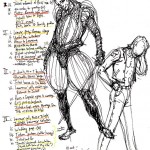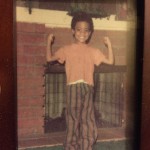 Look and Be Grateful (Holiday House 2015) is the most unusual project I’ve ever worked on in my 50 years as a children’s book illustrator/author.
Usually, a book starts with an idea that I’ll turn over and over in my head, sometimes letting it pop-up when it wants to, other times, sitting down and forcing myself to get right to it, jotting down notes, maybe making a quick sketch or two–nothing serious, nothing finished, just doodling with words and images.
Look and Be Grateful (Holiday House 2015) is the most unusual project I’ve ever worked on in my 50 years as a children’s book illustrator/author.
Usually, a book starts with an idea that I’ll turn over and over in my head, sometimes letting it pop-up when it wants to, other times, sitting down and forcing myself to get right to it, jotting down notes, maybe making a quick sketch or two–nothing serious, nothing finished, just doodling with words and images.Guest blogger: Tomie dePaola
 Look and Be Grateful (Holiday House 2015) is the most unusual project I’ve ever worked on in my 50 years as a children’s book illustrator/author.
Usually, a book starts with an idea that I’ll turn over and over in my head, sometimes letting it pop-up when it wants to, other times, sitting down and forcing myself to get right to it, jotting down notes, maybe making a quick sketch or two–nothing serious, nothing finished, just doodling with words and images.
Look and Be Grateful (Holiday House 2015) is the most unusual project I’ve ever worked on in my 50 years as a children’s book illustrator/author.
Usually, a book starts with an idea that I’ll turn over and over in my head, sometimes letting it pop-up when it wants to, other times, sitting down and forcing myself to get right to it, jotting down notes, maybe making a quick sketch or two–nothing serious, nothing finished, just doodling with words and images.


 For years, I heard bizarre, thrilling stories about Dmitri Shostakovich’s Seventh Symphony; how it was written by the Soviet composer in the besieged city of Leningrad as the Nazis bombed the city; how it was performed there by a starving orchestra while the Red Army shelled the Germans to protect the concert hall; and how it was put onto microfilm and slipped out of the USSR, flown to Tehran, driven across the desert to Cairo, and finally brought to America to interest the United States in the Soviet cause.
For years, I heard bizarre, thrilling stories about Dmitri Shostakovich’s Seventh Symphony; how it was written by the Soviet composer in the besieged city of Leningrad as the Nazis bombed the city; how it was performed there by a starving orchestra while the Red Army shelled the Germans to protect the concert hall; and how it was put onto microfilm and slipped out of the USSR, flown to Tehran, driven across the desert to Cairo, and finally brought to America to interest the United States in the Soviet cause. 
 Drawing a graphic novel is a bit like making a film—on your own. The artist becomes the writer, director, production crew, costume designer, art director, location scout, cinematographer, the special effects team, the actors, and the editor. Unlike film, however, the images are static and time, motion, and sound must be implied through picture sequences, or by descriptive text, such as “We waited for hours,” or “WHAM!”
Drawing a graphic novel is a bit like making a film—on your own. The artist becomes the writer, director, production crew, costume designer, art director, location scout, cinematographer, the special effects team, the actors, and the editor. Unlike film, however, the images are static and time, motion, and sound must be implied through picture sequences, or by descriptive text, such as “We waited for hours,” or “WHAM!”
 The other day, I was speaking to a group about my book EL DEAFO (Abrams, 2014), an autobiographical graphic novel that chronicles my experiences growing up as a deaf kid with hearing aids. After my presentation, a man, who happened to be deaf, asked me what I thought was the single most important technological advancement for deaf people since the invention of hearing aids. My answer? The Internet, and more specifically, email.
The other day, I was speaking to a group about my book EL DEAFO (Abrams, 2014), an autobiographical graphic novel that chronicles my experiences growing up as a deaf kid with hearing aids. After my presentation, a man, who happened to be deaf, asked me what I thought was the single most important technological advancement for deaf people since the invention of hearing aids. My answer? The Internet, and more specifically, email.
 I’m not sure if it’s wise to admit it, but I rarely read a manuscript twice before I decide whether or not to illustrate it. If I'm laboring over the decision during that first reading, it generally means that the story is just not speaking to me the way I need it to. It’s like telling a joke: if you have to tell it twice, or explain it, it’s probably not working for the other person. From the start, I liked Swing Sisters: The Story of the International Sweethearts of Rhythm by Karen Deans (Holiday House, 2015; Gr 2-5). Who wouldn’t want to illustrate a story about an all-girl band that rose from such humble beginnings to such lofty heights?
I’m not sure if it’s wise to admit it, but I rarely read a manuscript twice before I decide whether or not to illustrate it. If I'm laboring over the decision during that first reading, it generally means that the story is just not speaking to me the way I need it to. It’s like telling a joke: if you have to tell it twice, or explain it, it’s probably not working for the other person. From the start, I liked Swing Sisters: The Story of the International Sweethearts of Rhythm by Karen Deans (Holiday House, 2015; Gr 2-5). Who wouldn’t want to illustrate a story about an all-girl band that rose from such humble beginnings to such lofty heights?
 I remember sitting in my sixth grade class at Marian Anderson Elementary in Compton, California, when February rolled around and my teacher, Mr. Johnson, hung up the faces of Black History Month around the room. Sojourner Truth, Rosa Parks, Frederick Douglass, Harriet Tubman, and Dr. Martin Luther King, Jr. surrounded us until early March. Each picture had information about the person depicted on the back of the image, and the pictures hadn’t changed since first grade. With no new countenances added each year, it was as if once black Americans had achieved equal rights in the law books, our history was complete.
I remember sitting in my sixth grade class at Marian Anderson Elementary in Compton, California, when February rolled around and my teacher, Mr. Johnson, hung up the faces of Black History Month around the room. Sojourner Truth, Rosa Parks, Frederick Douglass, Harriet Tubman, and Dr. Martin Luther King, Jr. surrounded us until early March. Each picture had information about the person depicted on the back of the image, and the pictures hadn’t changed since first grade. With no new countenances added each year, it was as if once black Americans had achieved equal rights in the law books, our history was complete.